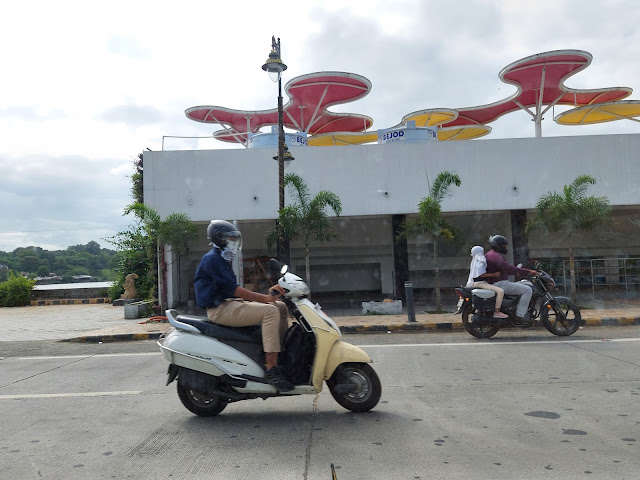No rut of the locals, no taking buses, no waiting in queues, no tall building around, no over honking - perhaps these are things that make smaller towns easy for the megacity breed. The deintensification of everyday life - even to such a mid-extent - allows one to savour time through what is perceived as slowness. One feels like he/she is able to give more time to smaller acts - of getting up, having coffee, getting ready, having lunch...everything gets its space in life rather than becoming a chore. It is the un-routining that salvages the mind from feeling burnt out.
Architecturally, one is navigating cozier, yet spaced out neighbourhoods, more greenery, less vehicular traffic on a general day and optimised commute in smaller cities. The outer limits of the city of Nagpur are just about 30-40 minutes apart, they say. (for inevitable comparison - Mumbai is also a linear city with a much larger area spread, with different parts connected disparately). Getting from point A to point B thus, does not involve too much planning since these are reachable within 15-20 minutes. Passing through low rise settlements establishes a new perspectival regime where the eye is able to see further, thereby increasing the scope of wandering too.
This is not to say that Nagpur is not intense. There are parts of the city which are equally bustling and transforming. The drive for infrastructural upgradation is rampant across all cities, including Nagpur. Thus, getting a metro, a set of malls, tall residential and commercial establishments is their claim to modernity. Nagpur was also decking up for the G20 summit, and it being the land of Nitin Gadkari, infrastructure has to be the priority. Yet, in comparison to Pune, Nagpur seemed much more contained and slower.
Nagpur is roughly the geographical centre of the country of India. This was established and built as a milestone by the British during the Great Trigonometrical Survey of India in 1907. Today, one passes by the Zero Mile, or the (0,0) coordinate of India on ground in Nagpur as if it was a roadside urban infrastructure. We kept feeling that this spot did not get its architectural presence within the scheme of planning of Nagpur city. The NMC website informs us how "[t]he British Government made Nagpur the capital of the new state named Central Province in mid-19th century and it remained so till 1956, after which it became the second capital of Maharashtra. Thus Nagpur has enjoyed the status of being the administrative centre of Central India during the ancient and medieval eras." Nagpur was earlier a part of Madhya Pradesh, but culturally got subsumed into the Vidarbha region of Maharashtra eventually.
The older part of the city is the Mahal area that was filled with Ganesh and Gauri idols for the upcoming festival of Ganesh Chaturthi. The variety of parapharnelia for rituals of worship are worth watching in the shops. As they come together, they make their beautiful patterns. Shops turn into mini museums, as cabinets of curiosities. It is therefore that we took a slow trail through the lane that sells these items. Saving ourselves of the rising temperatures, we also went to my friend's ancestral house, which wasn't much old, but displayed interesting pattern in which the house was cultured.
Other than that, we went for the Pohe with tari for breakfast, visited the TDS for lunch, the Varhadi Vyanjan for a traditional Nagpuri dinner. We snacked at a Samosa place near Futula lake, shopped at Apna Bazaar for some clothes, walked past the market squares of Nagpur and came back home with still time in hand. This is not to say we were tired, but we could accomplish a lot in a day.
Amongst things architectural, we walked along the Birdy (Burdee) area (which is a slipped version of Buldi of Sitaburdi), the Manormabai Mundle University Campus, saw the architecture college, spent time by the Futula Lake. Alongside the edge of the lake we observed new developments such as a mini stadium facing the lake and a large oversized complimentary parking lot building eating up into the green pastures off the lake. As we drove by the stadium, we realised how the stadium cut off the visual connection of people completely from the road. While the building in itself seemed very articulate and scaled - with the seating on the top facing the lake and the space below becoming the shop line on the road - it missed the essential urban gesture of how it ought to configure itself to preserve and privilege the existing urban relationships that people share with the lake.
We savoured the shopping centres in the city of Nagpur. These shopping centres share a distinct relationship with the street wherein they submerge themselves just half floor below the ground creating equal proximity for two levels from the road (instead of one), thus doubling up the affordance for shopping visibility. Further, they create a soft, scaled interface with the street, and step back to create an external edge that is not stark and flat, but wraps people around the building. The upper levels are often reserved for offices or residences. This type, that became common during the '90s were fast taken over by malls within megacities like Mumbai. Today, we see that most malls lie defunct or passive, and run on their recreational spaces like food courts or cinema halls. The essential character of shopping remains merely a window. The older shopping centres seemed to be an economic and elegant response, which graciously survive in these cities. Many of these shopping centres are decked and facelifed in glass panels. They too, perhaps, loom through the risk of conversion - but architecturally they demonstrate a complex resolution of organised shopping.
























No comments:
Post a Comment